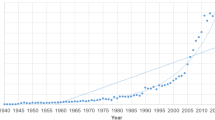Abstract
This study applies bibliometric analysis to investigate the quantity and citation impact of scientific papers in the field of complementary and alternative medicine (CAM). The data are collected from 19 CAM journals in the Science Citation Index Expanded (SCI-E) database during 1980–2009, and 17,002 papers are identified for analysis. The study analyzes the document types, geographical and institutional distribution of the authorship, including international scientific collaboration. This study suggests that the major type of document is original article. The CAM papers are mostly published by North America, East Asia, and European countries, of which publications authored in East Asia are cited most. Country-wise, major contributors of CAM papers are from USA, People’s Republic of China, India, England and Germany. India has the highest CPP value, attracting high attentions in CAM community. This article also finds that international co-authorship in the CAM field has increased rapidly during this period. In addition, internationally collaborated publications generate higher citation impact than papers published by authors from single country. Finally, the research identifies productive institutions in CAM, and China Medical University located in Taiwan is the most productive organization.



Similar content being viewed by others
References
Barnes, J., Abbot, N. C., Harkness, E. F., & Ernst, E. (1999). Articles on complementary medicine in the mainstream medical literature—An investigation of MEDLINE, 1966 through 1996. Archives of Internal Medicine, 159(15), 1721–1725.
Clegg, M. T., & Boright, J. P. (2009). Adapting to the future: The role of science academies in capacity building. International Journal of Technology Management, 46(1–2), 108–119.
Danell, J. A. B., & Danell, R. (2009). Publication activity in complementary and alternative medicine. Scientometrics, 80(2), 539–551.
Eskinazi, D., & Hoffman, F. A. (1998). Progress in complementary and alternative medicine: Contribution of the National Institutes of Health and the Food and Drug Administration. Journal of Alternative and Complementary Medicine, 4(4), 459–467.
Food and Drug Administration. (2006). Guidance for Industry on Complementary and Alternative Medicine Produces and Their Regulation by the Food and Drug Administration. Retrieved November 26, 2010 from http://www.fda.gov/OHRMS/DOCKETS/98fr/06d-0480-gld0001.pdf.
Garfield, E. (1970). Citation indexing for studying science. Nature, 227(5259), 669–671.
Gehanno, J. F., Takahashi, K., Darmoni, S., & Weber, J. (2007). Citation classics in occupational medicine journals. Scandinavian Journal of Work, Environment and Health, 33(4), 245–251.
Gray, C. M., Tan, A. W. H., Pronk, N. P., & O’Connor, P. J. (2002). Complementary and alternative medicine use among health plan members. A cross-sectional survey. Effective Clinical Practice, 5(1), 17–22.
He, T. W. (2009). International scientific collaboration of China with the G7 countries. Scientometrics, 80(3), 571–582.
Hesketh, T., & Zhu, W. X. (1997). Health in China—Traditional Chinese medicine: One country, two systems. British Medical Journal, 315(7100), 115–117.
Mills, S. Y. (2001). Regulation in complementary and alternative medicine. British Medical Journal, 322(7279), 158–160.
National Center for Complementary and Alternative Medicine. (2004). Expanding Horizons of Health Care Strategic Plan 2005–2009. Maryland: NIH.
Schmidt, K., Pittler, M. H., & Ernst, E. (2001). A profile of journals of complementary and alternative medicine. Swiss Medical Weekly, 131(39–40), 588–591.
Sharma, H., Chandola, H. M., Singh, G., & Basisht, G. (2007). Utilization of ayurveda in health care: An approach for prevention, health promotion, and treatment of disease. Part 2—Ayurveda in primary health care. Journal of Alternative and Complementary Medicine, 13(10), 1135–1150.
Thomas, K., & Coleman, P. (2004). Use of complementary or alternative medicine in a general population in Great Britain. Results from the National Omnibus survey. Journal of Public Health, 26(2), 152–157.
Thomson Reuters. (2010). Science citation index expanded. Retrieved April 2, 2010 from http://thomsonreuters.com/products_services/science/science_products/a-z/science_citation_index_expanded/.
Tindle, H. A., Davis, R. B., Phillips, R. S., & Eisenberg, D. M. (2005). Trends in use of complementary and alternative medicine by US adults: 1997–2002. Alternative Therapies in Health and Medicine, 11(1), 42–49.
Van den Berghe, H., Houben, J. A., de Bruin, R. E., Moed, H. F., Kint, A., Luwel, M., et al. (1998). Bibliometric indicators of university research performance in Flanders. Journal of the American Society for Information Science, 49(1), 59–67.
Van Oudenhoven, J. P., & van der Zee, K. I. (2002). Successful international cooperation: The influence of cultural similarity, strategic differences, and international experience. Applied Psychology-an International Review, 51(4), 633–653.
Wahlberg, A. (2006). Bio-politics and the promotion of traditional herbal medicine in Vietnam. Health, 10(2), 123–147.
World Health Organization. (2002). WHO Traditional Medicine Strategy 2002–2005. Geneva: WHO.
Zhong, H. L., & Jia, Q. (2006). Survey report of national healthcare system in North Korea (in Chinese). Chinese Journal of Information on Traditional Chinese Medicine, 13(2), 89–90.
Author information
Authors and Affiliations
Corresponding author
Rights and permissions
About this article
Cite this article
Fu, JY., Zhang, X., Zhao, YH. et al. Bibliometric analysis of complementary and alternative medicine research over three decades. Scientometrics 88, 617–626 (2011). https://doi.org/10.1007/s11192-011-0391-0
Received:
Published:
Issue Date:
DOI: https://doi.org/10.1007/s11192-011-0391-0




